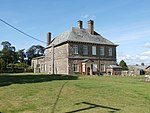Huish, Torridge

Huish (anciently Hiwis) is a small village, civil parish and former manor in the Torridge district of Devon, England. The eastern boundary of the parish is formed by the River Torridge and the western by the Rivers Mere and Little Mere, and it is surrounded, clockwise from the north, by the parishes of Merton, Dolton, Meeth and Petrockstowe. In 2001 the population of the parish was 49, down from 76 in 1901.The village lies just off the A386 road, about five and a half miles north of Hatherleigh, and about seven miles south of Great Torrington. It was a member of the historic hundred of Shebbear and was in the deanery of Torrington.The majority of the parish consists of parkland belonging to Heanton Satchville, the seat of Baron Clinton; the mansion-house is a few hundred yards to the north of the church.
Excerpt from the Wikipedia article Huish, Torridge (License: CC BY-SA 3.0, Authors, Images).Huish, Torridge
Torridge District
Geographical coordinates (GPS) Address Nearby Places Show on map
Geographical coordinates (GPS)
| Latitude | Longitude |
|---|---|
| N 50.881 ° | E -4.086 ° |
Address
EX20 3QE Torridge District
England, United Kingdom
Open on Google Maps









